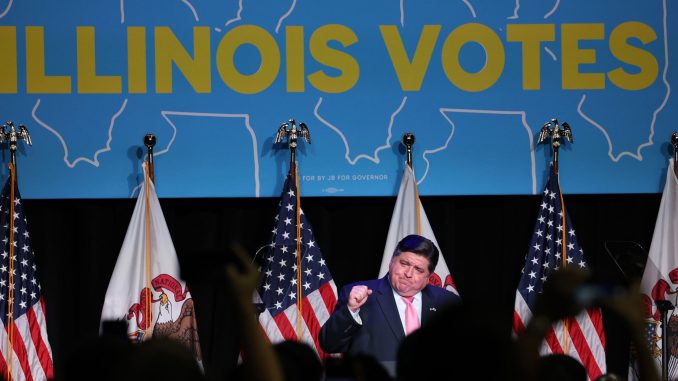
Lots of people complain. But when they’re really fed up, they “vote with their feet.” And by that metric, Illinois is one of the most unpopular states in the nation.
The latest Census Bureau data show that the Land of Lincoln is hemorrhaging people at an astonishing rate—and public policy there is likely to blame.
From July 2021 to July 2022, more than 142,000 people moved out of state than moved in. Only New York state experienced a faster rate of population decline.
To put that loss into perspective, consider that about 127,000 Illinois residents died in that same period. In terms of state population change, Illinois’ emigration problem effectively doubled its death rate.
So why are people fleeing Illinois in droves?
Some blame the harsh Midwestern winters for Illinois’ recent population drain, but heavy snowfall and biting wind chills are not new to Illinois. Moreover, a hefty chunk of those leaving (33%) simply move across the state line, relocating to the five neighboring states, including Wisconsin, which is farther north.
What has changed in the Prairie State is taxation, regulation, and other government practices. Soft-on-crime policies have turned Chicago, the state’s largest population center, into a complete basket case. The Windy City accounted for about half the growth in homicides nationwide in 2016 and has some of the highest crime rates in the nation. More than a dozen people were shot there over the Christmas weekend alone.
And all Illinoisans labor under some of the highest taxes in the country. Here are the “highlights”:
- 15th-worst overall tax climate.
- 13th-highest personal income taxes per capita and the sixth-highest corporate income taxes per capita.
- Eighth-highest combined state and local sales tax rate.
- 16th-highest excise tax on distilled spirits and 12th-highest on wine.
- Highest state and local cellphone tax in the country — combined with federal tax, cellphone bills in Illinois are subject to a tax rate more than 34%.
- Seventh-highest state and local excise-tax collections per capita.
- Second-highest property tax rate.
- Tied for the second-highest estate tax rate.
- Second-highest taxes on gasoline at 60 cents per gallon, which increased on Jan. 1, and then will increase again in July.
There is no sign of tax relief in sight. Springfield’s affinity for spending, which outpaces even the sky-high taxes, has led to crushing levels of borrowing. State and local debt per capita are the fourth-highest in the nation, at more than $13,000.
Illinois also has the second-worst ratio of funded public pensions at just 37%. This means that 63% of the money promised to retirees is missing from state coffers and will have to be raised with higher taxes in the future—much higher taxes.
It’s no wonder Illinois’ credit rating is nearly “junk” status, the point at which many financial advisers’ fiduciary duty would prohibit them from recommending Illinois bonds to clients.
Some might argue that taxes in Illinois are not that bad, because the state is not the worst in any major type of tax. That is certainly true, but there is nothing redeeming in the tax code, either. All taxes are relatively high, and the Land of Lincoln is tied for the 10th-highest state and local tax burden as a share of residents’ income.
In contrast, Tennessee has the second-highest combined state and local sales taxes in the country, but virtually no other taxes. Consequently, the Volunteer State has the lowest total tax burden per capita and is tied for the second-lowest total tax burden as a share of residents’ income.
Illinois needs to get its act together by cutting taxes and spending while getting tough on crime. Otherwise, it will continue to bleed people. Lawmakers unwilling to act should be ready to ask, “Will the last Illinoisian please turn out the lights?”
This article originally appeared at The Washington Times.
Have an opinion about this article? To sound off, please email letters@DailySignal.com and we’ll consider publishing your edited remarks in our regular “We Hear You” feature. Remember to include the url or headline of the article plus your name and town and/or state.

